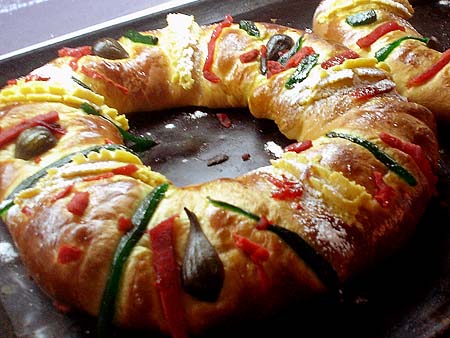Unlike in the USA and Canada, where gifts are exchanged on Christmas Day (25 December), the original tradition in Mexico over the Christmas season was to exchange presents on Three Kings Day (Día de los Reyes, 6 January). In the Christian calendar, 6 January marks the Feast of the Epiphany, the day when the magi arrived in Bethlehem with their gifts for the infant Jesus. In homage to this occasion, Mexican children would dutifully stuff the largest shoes (or box) they could find with straw, and leave them outside their bedroom door on the night of January 5, in anticipation of finding new toys the following morning.
In the 20th century the Three Kings Day tradition in some regions of Mexico broke down in the face of the enormous consumer-oriented publicity from north of the border, which stressed Christmas (rather than Epiphany) gifts. Naturally, however, some greedy Mexican middle- and upper-class children expect to receive gifts on both days, claiming that parents and grandparents should not only preserve the old customs but also embrace the new version! Equally, children with parents who are separated or divorced also often receive gifts on both 25 December and 6 January, with each parent taking responsibility for one of the two festive days.
Even where it is no longer a day to exchange gifts, 6 January is still very much a family day throughout Mexico. In the late afternoon or early evening, it is traditional for the whole family to share a rosca. Roscas are ring-shaped loaves of sweet bread, sold to be eaten on special occasions. The roscas for Three Kings Day each contain a small plastic (formerly ceramic) muñeco (doll). These muñecos were originally ceramic, but are now more usually plastic. The recipient of the piece of rosca containing the muñeco has to throw a party on 2 February (Candlemas day, Día de la Candelaria) for all those present at the sharing of the rosca. It is customary to provide tamales to feed everyone gathering on Candlemas day. In some parts of southern Mexico, guests expect to be served home-made mole, a sauce which contains dozens of ingredients including nuts, chocolate and numerous spices, and which requires many hours of arduous preparation.
- Los Tamales – 500 years at the heart of the fiesta (Karen Hursh Graber, MexConnect)
- Demystifying mole – Mexico’s national dish (Karen Hursh Graber, MexConnect)
In 2011, Mexico City residents were treated to an early Three Kings Day present. On Sunday 2 January, the main central square in Mexico City filled with people pushing through the crowds to receive their free portion of the world’s largest ever rosca – a staggering 720 meters long, 90 cm wide and weighing 9,375 kilograms. More than 300,000 people eventually collected a piece to take home for their families to enjoy sometime on Three Kings’ Day.
And if you think making mole is arduous, then just imagine how much work was required to make this enormous rosca! The finished bread was made from 6,000 kg of flour, 3,000 kg of butter, 38,000 eggs, 1,000 kg of fruit, 1,000 liters of milk, and 220 kg of sugar; its preparation took 16,000 man-hours. Given the rising levels of obesity in Mexico, it is to be hoped that the recipe used was for a “reduced calorie” rosca…
Credits: Thanks to Fatimah Araneta for suggesting valuable modifications to the original article, and to Cristina Potters for emphasizing that gift-giving on Three Kings Day is still very much alive and well in much of central and southern Mexico. Cristina Potters’ blog Mexico Cooks! has a comprehensive account of the significance of the cuisine associated with Three Kings Day and Candlemas Day.
Many aspects of Mexico’s culture feature in Geo-Mexico: the geography and dynamics of modern Mexico, a handy reference guide to all aspects of Mexico’s geography. If you have enjoyed this post, please consider gifting a copy of Geo-Mexico to a friend.


